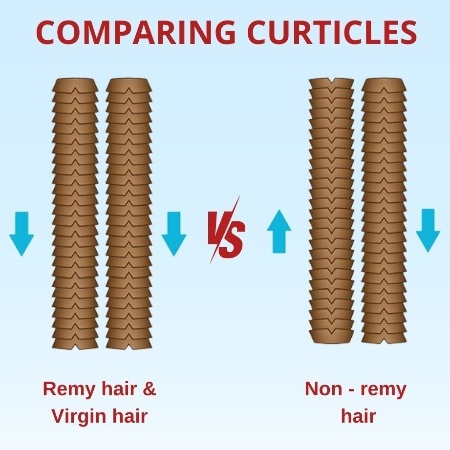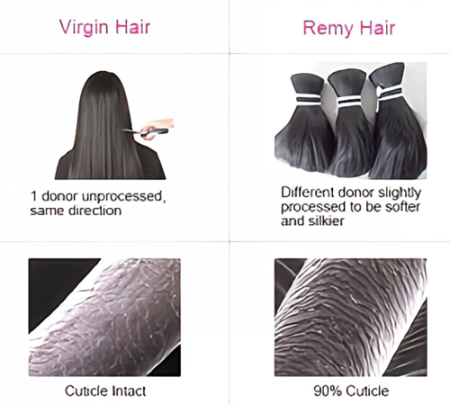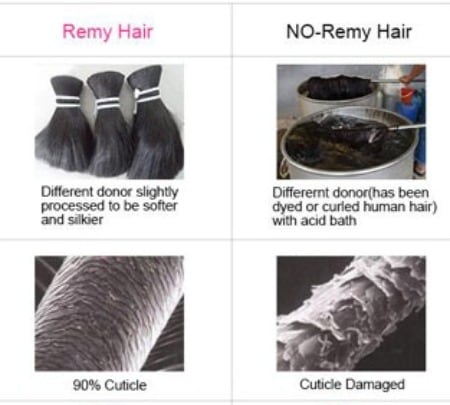Virgin Hair vs Remy Hair vs Human Hair, Which One Wins?
If you've ever browsed or purchased a wig or hair extensions, you've probably noticed words like "human hair", "virgin hair", "Remy hair", and "non-Remy hair". For most people, these words are quite confusing. Simply put, they can be collectively referred to as human hair, but there is a huge difference. Today, I'm going to clear up this confusion and help you better differentiate as well as buy the right human hair wig products.
Check Three Different Types of Human Hair
Human hair can be divided into different kinds from different perspectives, which is why many wig vendors will write various descriptions about the material on the product page. For example, in terms of curl pattern, there are straight, wavy, curly, etc, and in terms of hair origin, there are Brazilian, Indian, Burmese, etc, for human hair, especially for hair bundles. However, today we are going to differentiate human hair by its processing and quality: virgin hair, Remy Hair, and Non-Remy Hair.

Source: Instagram
Virgin Hair - Without Any Chemical Processing
What is virgin hair? Raw virgin hair is the highest quality of human hair and usually comes from a single donor. It is 100% natural, which means a virgin human hair wig has never been chemically treated, colored, or altered in any way.
The cuticle of the hair is intact and aligned in the same direction, which prevents tangling and shedding. The hair here is basically the same as natural hair and can be styled, colored, etc. It is also more durable due to its quality.
Remy Hair - Minimally Processed
What is Remy hair? Remy hair is also high-quality human hair, but unlike virgin hair, Remy human hair may have undergone a minimal amount of processing, such as coloring or perming, to achieve a new color or texture.
The main feature of Remy hair is that the cuticle is preserved and aligned in one direction, which helps to keep the hair smooth and shiny and reduces tangles.
Non-Remy Hair - Heavily Chemically Treated
Non-Remy hair is the least expensive and of relatively poorest quality of the three types of human hair. This hair is collected from a variety of sources, which may include the salon floor, and has an untidy cuticle. As a result, the hair is more prone to tangles and knots.
In order for the hair to be usable, non-Remy hair undergoes extensive chemical treatments, including removing the cuticle and applying silicone to add temporary smoothness and shine.
Remy Hair vs Virgin Hair: What Are the Differences?

Source: UNice
We can say that all virgin hair is Remy hair, but not all Remy hair is virgin hair, however, they are all high-quality options.
✨ Processing: Virgin hair is completely unprocessed with any chemicals, whereas human hair Remy hair may have only undergone minimal processing such as coloring or perming.
✨ Hair source: Virgin hair comes directly from a single donor and has never been altered. Remy hair may come from one or more donors, as long as the cuticle remains intact and aligned in the same direction.
✨ Cost: Virgin hair is usually more expensive than Remy hair because it is less processed and comes from a single source.
✨ Longevity: If properly taken care of, virgin hair usually lasts a year or more, compared to 6-12 months for Remy hair.
✨ Versatility: Virgin hair can be colored or styled more easily without causing damage, while Remy hair may have limitations in coloring.
✨ Cuticle Integrity: Both virgin hair and Remy hair have an intact cuticle that is oriented in the same direction, although the cuticle of virgin hair never changes.
Remy Hair vs. Non-Remy Hair: What Are the Differences?

Source: UNice
Overall, Remy hair is a higher grade of hair and more durable, while non-Remy hair is a more affordable option.
✨ Processing: Remy hair is minimally processed. Non-Remy hair is more chemically processed for more coloring and styling needs.
✨ Cost: Remy hair is more expensive because it is of higher quality; non-Remy hair is more economical.
✨ Longevity: Remy hair lasts longer, usually up to 6-12 months with proper care. Non-Remy hair has a shorter lifespan, about 4-6 months.
✨ Quality: Remy hair has a smoother, shinier, healthier appearance. Non-Remy hair is a little less shiny, but if you don't like your hair too shiny, you can buy non-Remy hair.
✨ Cuticle integrity: Remy hair has all cuticles collected in one direction, making it easier to detangle without removing the cuticle. Whereas, since non-Remy hair is collected randomly, hair manufacturers need to make it smoother and less prone to tangling by removing the cuticle.
✨ Washing: Remy hair washes better, but both types of hair need to be washed with care to better maintain their texture.
How to Choose Between Virgin Hair, Remy Hair, and Non-Remy Hair?
The more questionable human hair comparisons have been listed above, but to help you make a clearer and more intuitive choice, check out the table below.
| Human Hair Types | Virgin Hair | Remy Hair | Non-Remy Hair |
| Hair Quality | Highest | High | Low |
| Hair Source | Single donor | Single or multiple donors | Multiple sources |
| Hair Processed | Not processed at all | Minimally processed | Heavily processed |
| Hair Tangles | Least | Few | Easier |
| Hair Price | Most expensive | Medium | Most affordable |
| Hair Lifespan | More than 1 year | 6-12 months | 4-6 months |
🎁 Limited Time Offer: Free Bundle/Closure + Savings
UNice is thrilled to announce an exclusive offer! Purchase our hair bundles, and once you meet a certain spending limit, you'll get a FREE hair bundle or lace closure! And you can enjoy great savings on your overall bundle purchase. Don’t let this opportunity pass you by — see the details below!
Buy Hair Bundles, Get an Extra Free Hair Bundle
💰 Coupon Code: GFB
Free 8" Bundle+5% OFF( Orders≥$179 )
Free 16" Bundle+5% OFF( Orders≥$209 )
Free 20" Bundle+5% OFF( Orders≥$239 )
Buy Hair Bundles, Get a Free Lace Closure
💰 Coupon Code: GFC
Free 8" Bundle+5% OFF( Orders≥$179 )
Free 12" Closure+5% OFF( Orders≥$209 )
Free 16" Closure+5% OFF( Orders≥$239 )
Free 20" Closure+5% OFF( Orders≥$299 )
Your Perfect Hair Choice
We hope this guide has enabled you to make an informed decision when choosing between virgin hair, Remy hair, and non-Remy hair. Understanding the unique qualities of each type of hair will ensure that you get the best value for your investment. Explore our exclusive collection today to find the perfect hair for your style and needs now. You deserve the best, and UNice is here to help you get it!
